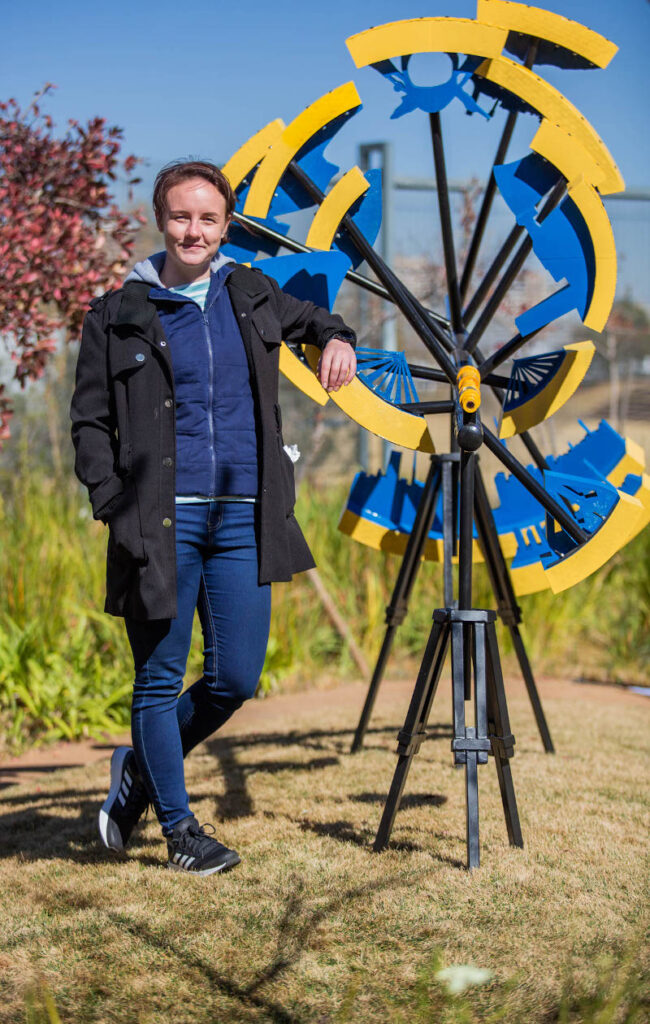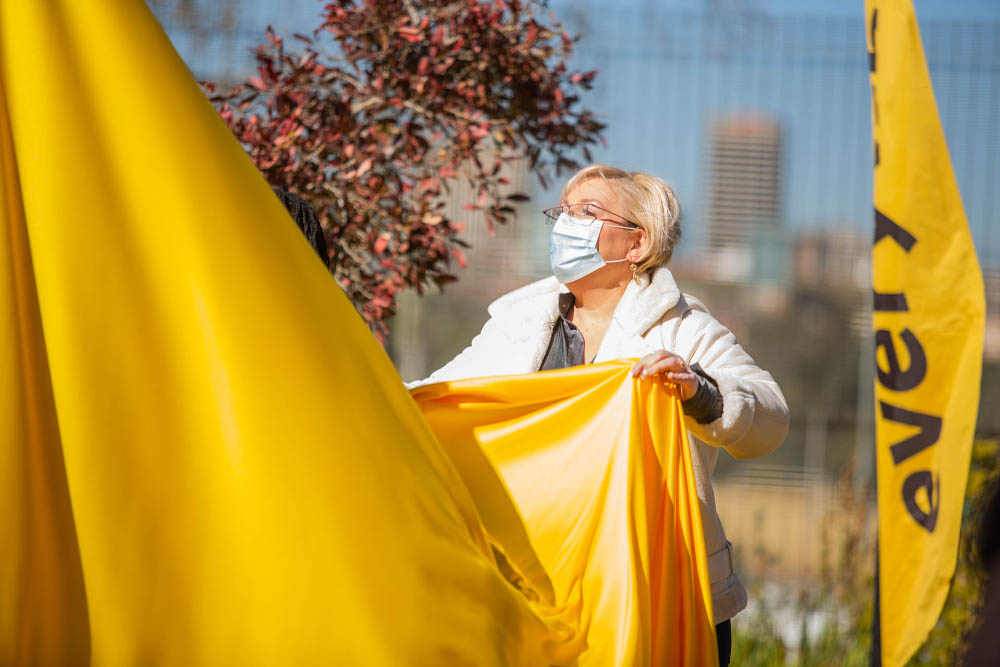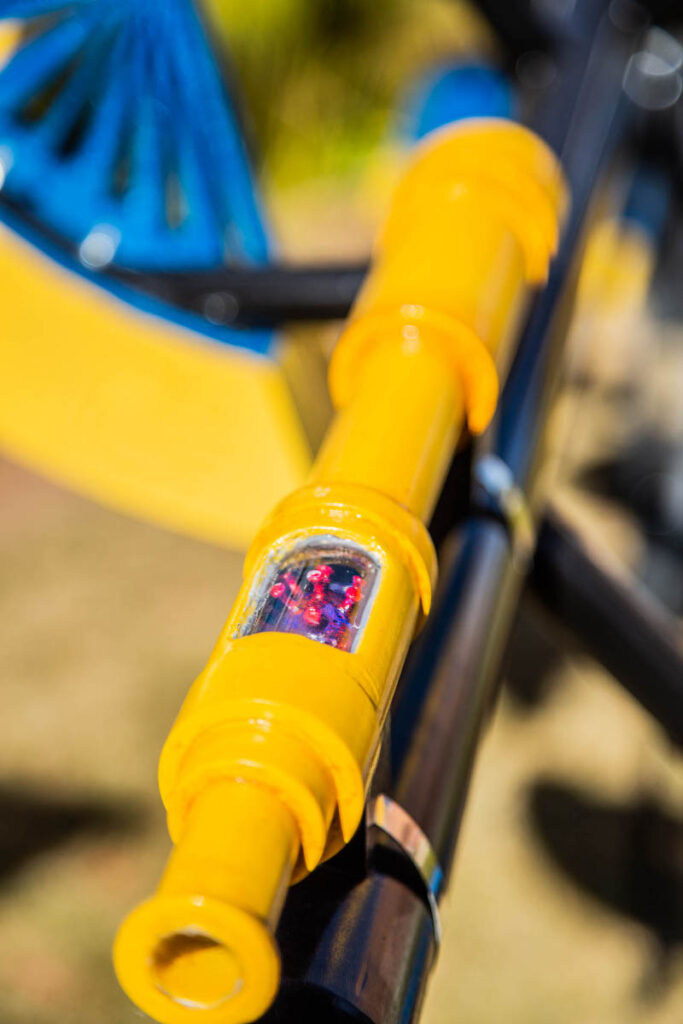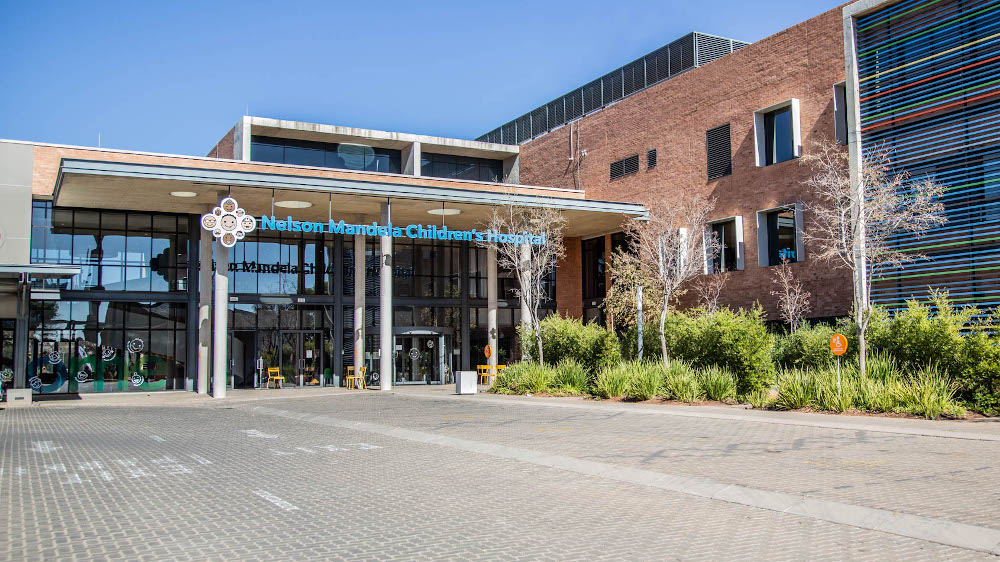Nomthi Mnisi, looking for new perspective in the Shift-19 artwork that was donated to the Nelson Mandela Children’s Hospital this week
Perspective will help people move forward from the difficulties and setbacks that the coronavirus pandemic has posed since it began. Element artist Alexa Pienaar has incorporated this into her prize-winning installation that will be housed by the Nelson Mandela Children’s Hospital from this week.
“I focus predominantly on how children and younger generations may perceive their — and our — current situation and how they or we may potentially comport our lives moving forward,” she says. “Covid-19 has had an impact on how we see the world, on our perspectives, and this comes through in the piece.”
 Alexa Pienaar, the commissioned artist, next to her art work called Shift-19
Alexa Pienaar, the commissioned artist, next to her art work called Shift-19
Pienaar, who recently completed her Master’s in Fine Arts, was selected by MTN SA Foundation in the #ItsGoTime project from among five emerging young artists to do a sculpture that commemorates the pivotal role South African health workers are playing to help South Africa get through the Covid-19 pandemic.
The artwork has been donated and installed at the Nelson Mandela Children’s Hospital in Johannesburg, where it was unveiled on Wednesday.
“With the prolonged impact Covid-19 pandemic has had on South Africa and on artists and the art world in particular, we decided that now was the right time to embark on a positive project. Through this project, MTN Foundation SA is enabling South African artists to get up, get going, and progress through the Covid-19 pandemic,” says Jacqui O’Sullivan, MTN SA’s executive for corporate affairs.
 Jacqui O’Sullivan from MTN unveiled the art work at Nelson Mandela Children’s Hospital this week
Jacqui O’Sullivan from MTN unveiled the art work at Nelson Mandela Children’s Hospital this week
O’Sullivan says the judging panel, which selected Pienaar from among five artists invited to make submissions using technology as a medium, was “delighted” with her concept. It commissioned her to work with Mohammed Hassan, at Red Apple 3D printing, to bring the concept to fruition.
All five artists, who were called upon to submit concepts for artworks that use technology as the medium, received financial support for their involvement in the project from MTN SA Foundation. The other artists who participated were Neo Mahlangu, Keneilwe Mokoena, Tristan Roland and Setlamorago Mashilo.
Pienaar’s installation Shift-19 is 2.5m long and consists of 15 3D printed discs that represent the discs of a disassembled telescope. They are fixed to a steel frame and lined with flat cut-outs, with landscape imagery in their inner semi-circles and textured patterns of the virus’s round shapes on their outer platforms.
There is also a smaller telescope through which to, metaphorically, view the larger “pieces” of the telescope and, in the background, the city of Johannesburg.
Pienaar says South Africans — and people worldwide — have been facing many challenges in their everyday lives. They have been adapting to the dangers and complications posed to societies by the Covid-19 pandemic, which forced lockdowns from early last year. “Without a doubt, healthcare workers have had an enormous impact on our safety, sanity and sense of hope on many levels,” she says.
Pienaar says notions such as health, safety, progress, technological connection, the future of younger generations and our perspective of our changing lives came to the fore in this project. “While we continue to distance ourselves from our families, friends and other relatives, and may feel physically isolated, new avenues of technological exploration and reconnection become possible,” she says.
 Peering through the telescope reveals a large depiction of the coronavirus
Peering through the telescope reveals a large depiction of the coronavirus
The coronavirus functions on both a microscopic and macroscopic level, Pienaar says. “Healthcare workers analyse and dissect it on a microscopic level while larger communities, cities and countries encounter it on a larger landscape.”
People are confronted with the virus too on “a close, intimate and familial level as well as a scope as large as the prospects of our futures and the futures of our loved ones”.
Pienaar, who is intrigued with landscapes, uses layers of city skylines and other significant shapes in the disassembled pieces of the telescope. When viewed from the front of the installation, these pieces construct a large silhouette of a healthcare worker putting on a mask while walking towards the viewer, coat flapping behind.
This resembles a superhero pulling open everyday clothes to reveal a superhero outfit underneath. “This is done in remembrance of the heroic efforts of the healthcare workers during these challenging times, as the silhouette is that of bravery,” she says.
Objects surround the silhouette but it is defined by the absence of objects, rather than the objects themselves. This was done for technical reasons, Pienaar says, but “it can also be interpreted as the elimination or eradication of Covid-19 through the efforts of healthcare workers”.
The textures and colours of cut-outs placed within semi-circles of the telescope complement this and simulate the textures and colours of commercial face masks or sanitising hand wipes.
“They also begin to function like walls, as we are often confined within the walls of our houses or workplaces and distance ourselves from one another, but with the ultimate goal of preservation and protection,” she says.
Technological advancement and digital connection elements incorporated in the installation — the textures and the disassembled structure of the 3D-printed telescope — represent how technology has become more necessary to stay connected with each other and to steer our everyday lives in a more technologically supported and digitally advanced direction.
When you look through the lens of the small telescope, it simulates how we view the world through a lens or screen, with the exponential growth of social media platforms since the rise of Covid-19, Pienaar says. But this view reminds of the underlying threat of the virus that we deal with on a daily basis, rather than finding an expected view of the city in the background, she says.
“Shift-19 is an interactive installation around which one moves and views the separate pieces, as one would shift one’s perspective and view a situation from multiple angles,” Pienaar says. “It serves to commemorate the efforts of healthcare workers and to promote the possibilities that we hold with regards to connection, communication and digitalisation. It ultimately serves as a symbol of realisation, adaptation and gratitude.”
Pienaar was born in Pretoria and grew up on a small farm in the Western Cape. She now lives in Johannesburg, where she studied at the University of Johannesburg.
She has showcased her work at various group exhibitions, including a solo master’s exhibition, including the annual group exhibition at the Pretoria Arts Association, the Sasol New Signatures Awards, the Johannesburg Turbine Art Fair and the Thami Mnyele Fine Arts Awards.
 The Nelson Mandela Children’s Hospital relies on donations to care for children
The Nelson Mandela Children’s Hospital relies on donations to care for children
Pienaar uses contemporary South African landscape elements as visual metaphors of her lived experiences, believing that they have forged her identity. She does this while trying to determine her place in contemporary South African society and her sense of being and belonging in it.
“I’m humbled to have been selected to commemorate healthcare workers. While we continue to distance ourselves from our families, friends and other relatives, and may feel physically isolated, new avenues of technological exploration and reconnection become possible,” says Pienaar.
The Nelson Mandela Children’s Hospital, where this sculpture will now stand, is a state-of-the-art specialist paediatric academic and tertiary referral hospital, but it also houses a notable art collection, O’Sullivan says.
CEO of the Nelson Mandela Children’s Fund, Konehali Gugushe, says: “The hospital provides child-centred highest quality medical services to children of Southern Africa, regardless of their social and economic status in a safe, comfortable, healing and yet playful environment for children.”
The hospital was founded by the fund and is one of its flagship projects.
Gugushe says Shift-19 will be placed within the Children’s Garden at the hospital for children to interact with. “We continue to celebrate the incredible work at the institution and the various partners who have joined us on our journey,” she says. “It was a natural fit, particularly because it’s placed there during Mandela Month.”
The hospital is currently running a fundraising campaign called #ServeLikeMadiba and Give Like They’re Yours, which is a call on the public to support the only dedicated children’s facility in Gauteng, and its patients and families.
During this month MTN SA Foundation is encouraging the public to donate through the Nelson Mandela Children’s Fund MoMo account at www.nelsonmandelachildrenshospital.org/mtn-momo/.
“Children with health conditions often experience feelings of loneliness and anxiety, a feeling that their lives are defined by their diagnosis,” says Bongi Dhlomo-Mautloa, art curator at the hospital, “and the interactive sculpture donation will delight the senses of the young patients during their healing journey. We therefore encourage South Africans to donate to the Nelson Mandela Children’s Hospital and help our children heal and grow.”
To donate to the Nelson Mandela Children’s Hospital, click on the link below:
www.nelsonmandelachildrenshospital.org/mtn-momo/